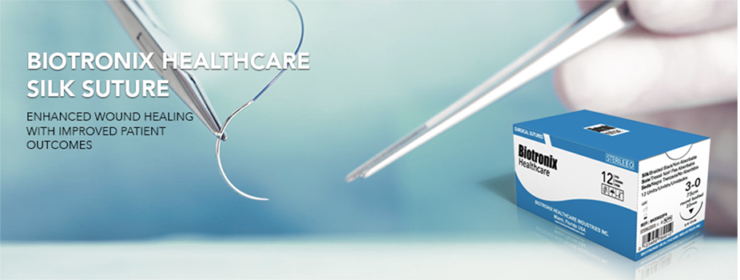Sutures Needles
Category
NEED MORE
INFORMATION
CONTACT US
Biotronix Healthcare Customer Service Associates are available 8:30am to 5:pm EST Monday thru Friday
North America Customer Service
Tel: (954) 320-6088
(954) 440-1572
customerservice@biotronixhealthcare.com
International Customer Service
Tel: (289) 813-0159
(416) 876-5035
customerservice@biotronixhealthcare.com
______________________________________
Sales and Orders
Tel: (954) 266-8944
sales@biotronixhealthcare.com
______________________________________
Regulatory Affairs
regulatory@biotronixhealthcare.com
______________________________________
Accounting Department
accounting@biotronixhealthcare.com
______________________________________
Call to speak with a knowledgeable Biotronix Healthcare specialist today.

Silk
Biotronix Healthcare Braided Silk Sutures are nonabsorbable sutures composed of intertwined thread from silk worm larva species Bombyx Mori . The silk fibers are treated to remove the naturally-occurring gum, bleached and braided to produce Silk surgical sutures.
Biotronix Healthcare’s Silk nonabsorbable Sutures have moderate tissue reactivity and as with any Silk Suture, although nonabsorbable, progressive degradation of the sutures may result in gradual loss of tensile strength over time.

Applications:
General closure, G. I. Tract, Plastic, Skin, Opthalmic, Cardiovascular Surgeries. Widely used as ligature.
Characteristics of Biotronix Healthcare’s Braided Silk sutures:
• Drill End Press Fit needles for maximum strength between thread and needles
• Uniformly coated with silicone to enhance handling characteristics
• Coating allows smooth passage through tissue
• Superb Handling properties
• Moderate tissue reactivity
• Tightly braided at a slow controlled rate and electronically inspected during the processing.
• Minimal memory
Packaging:
Individually packaged 12 or 36 per box.
Contraindications
The use of this suture is contraindicated in patients with known sensitivities or allergies to silk.
Due to the gradual loss of tensile strength which may occur over prolonged periods in vivo, silk should not be used where permanent retention of tensile strength is required.
Warnings
Users should be familiar with surgical procedures and techniques involving nonabsorbable sutures before employing Silk sutures for wound closure, as risk of wound dehiscence may vary with the site of application and the suture material used.
As with any foreign body, prolonged contact of any suture with salt solutions, such as those found in the urinary or biliary tracts, may result in calculus formation. Acceptable surgical practice should be followed for the management of infected or contaminated wounds. Do not resterilize. Discard opened packages and unused sutures.
Precautions
In handling this or any other suture material, care should be taken to avoid damage from handling. Avoid crushing or crimping damage due to application of surgical instruments such as forceps or needle holders. As with any suture material, adequate knot security requires the accepted surgical technique of flat and square ties with additional throws as warranted by surgical circumstance and the experience of the surgeon.
To avoid damaging needle points and swage areas, grasp the needle in an area one-third (1/3) to one-half (1/2) of the distance from the swaged end to the point. Reshaping needles may cause them to lose strength and be less resistant to bending and breaking. Users should exercise caution when handling surgical needles to avoid inadvertent needle sticks. Discard used needles in “sharps” containers.
Adverse reactions
Adverse effects associated with the use of this device include wound dehiscence, gradual loss of all tensile strength over time, allergic response in patients that are known to be sensitive to silk, calculi formation in urinary and biliary tracts when prolonged contact with salt solutions such as urine and bile occurs, infection, acute inflammatory tissue reaction, and transitory local irritation at the wound site. Broken needles may result in extended or additional surgeries or residual foreign bodies. Inadvertent needle sticks with contaminated surgical needles may result in the transmission of

